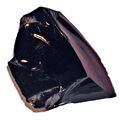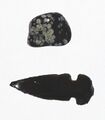- v50 information can now be added to pages in the main namespace. v0.47 information can still be found in the DF2014 namespace. See here for more details on the new versioning policy.
- Use this page to report any issues related to the migration.
Difference between revisions of "Obsidian"
(Obsidan now has proper yield values and no longer requires modding to enable rock short swords to be able to cut.) |
|||
| Line 7: | Line 7: | ||
==Rock short sword== | ==Rock short sword== | ||
| − | Obsidian can also be made into obsidian [[short sword]]s with one log at the craftsdwarf's workshop. If you embark on an obsidian [[mountain]] or manage to reach [[magma]] before finding metallic ores, these are good at first to defend your fort from early [[wolf]] and [[giant eagle]] attacks, but weak in comparison to any metal, | + | Obsidian can also be made into obsidian [[short sword]]s with one log at the craftsdwarf's workshop. If you embark on an obsidian [[mountain]] or manage to reach [[magma]] before finding metallic ores, these are good at first to defend your fort from early [[wolf]] and [[giant eagle]] attacks, but weak in comparison to any metal, Note that with the use of wood (presumably used in the handle), [[Elf|Elves]] will be offended if you trade obsidian swords and refuse the trade. |
Obsidian is the only rock that can be used to make stone-based weapons. | Obsidian is the only rock that can be used to make stone-based weapons. | ||
| + | |||
| + | Has of 40.05 obsidian was given proper yield values making these weapons much more viable than in previous versions which lacked defined yield values and used the defaults from the stone template which rendered them very blunt and unable to cut skin but now obsidian has glass like yield values which allow rock short swords to now properly hack unarmored bodies. | ||
==Obsidian formation== | ==Obsidian formation== | ||
Revision as of 06:10, 28 July 2014
| This article was migrated from DF2014:Obsidian and may be inaccurate for the current version of DF (v52.04). See this page for more information. |
| ||||||||||||||||||||||||||||||||||||
| Uses | ||||||||||||||||||||||||||||||||||||
|---|---|---|---|---|---|---|---|---|---|---|---|---|---|---|---|---|---|---|---|---|---|---|---|---|---|---|---|---|---|---|---|---|---|---|---|---|
| Properties | ||||||||||||||||||||||||||||||||||||
| ||||||||||||||||||||||||||||||||||||
| Contains | ||||||||||||||||||||||||||||||||||||
| ||||||||||||||||||||||||||||||||||||
v52.04 · v0.47.05 This article is about the current version of DF.Note that some content may still need to be updated. |
Obsidian is one of the types of "stone" (technically volcanic glass) that forms entire layers. Obsidian is also found surrounding magma pools and volcanoes, exactly 1 tile thick, and has the distinction of being the only stone that can be created during play. Obsidian is considered an economic stone by default; in order to allow general use at workshops and in architecture you must enable "obsidian" in the stocks "Stone" menu.
"Obsidian" is also the twelfth month of the dwarven calendar, covering late Winter.
Rock short sword
Obsidian can also be made into obsidian short swords with one log at the craftsdwarf's workshop. If you embark on an obsidian mountain or manage to reach magma before finding metallic ores, these are good at first to defend your fort from early wolf and giant eagle attacks, but weak in comparison to any metal, Note that with the use of wood (presumably used in the handle), Elves will be offended if you trade obsidian swords and refuse the trade.
Obsidian is the only rock that can be used to make stone-based weapons.
Has of 40.05 obsidian was given proper yield values making these weapons much more viable than in previous versions which lacked defined yield values and used the defaults from the stone template which rendered them very blunt and unable to cut skin but now obsidian has glass like yield values which allow rock short swords to now properly hack unarmored bodies.
Obsidian formation
Obsidian can be formed by mixing water and magma. Any tiles containing both water and magma will be replaced with unmined obsidian, generating abundant amounts of steam. When dumping water via a pond zone onto magma, the water has to fall free for at least one z-level (i.e. the pond zone must be two or more z-levels above the magma); otherwise only steam will be produced.
Most non-magma-safe objects that were in the magma prior to the formation of obsidian are completely destroyed, which can be an effective method of removing unwanted items or enemies, although long exposure times to magma are suggested to ensure destruction. All magma-safe items will be entombed in the tile, and can be regained by mining it along with any magma-unsafe items that happened to survive the casting process. No instances of globs of molten metal surviving obsidian formation have been noted, though apparently burning objects can remain on fire when cast in obsidian. The survival rate of magma-unsafe items is believed to depend on the exposure time to magma being short enough to not cause the item in question to melt or burn before obsidian formation occurs—fragile items placed in water that is then exposed to magma tend to survive casting unscathed. Creatures cast in obsidian die, even without significant exposure to magma. Creatures in cages will survive the casting process, though they may still die from exposure to the extreme temperature of magma.
Obsidian farming can be used to produce large amounts of obsidian for masonry, crafting, or construction.
Real Life
The use of obsidian to create short swords in Dwarf Fortress is almost certainly inspired by the macuahuitl, a weapon used by the ancient and medieval indigenous peoples of Mesoamerica, of which the Aztecs are the most well-known. The weapon itself is more club- than sword-like in construction, being a long wooden handle with extremely sharp prismatic blades of obsidian embedded in its sides, usually intended to be wielded with one hand, though larger two-handed variations were known.
[INORGANIC:OBSIDIAN]
[USE_MATERIAL_TEMPLATE:STONE_TEMPLATE]
[MELTING_POINT:13600]
[BOILING_POINT:16000]
[IMPACT_YIELD:1000000] from glass
[IMPACT_FRACTURE:1000000]
[IMPACT_STRAIN_AT_YIELD:2222]
[COMPRESSIVE_YIELD:1000000]
[COMPRESSIVE_FRACTURE:1000000]
[COMPRESSIVE_STRAIN_AT_YIELD:2222]
[TENSILE_YIELD:35000]
[TENSILE_FRACTURE:35000]
[TENSILE_STRAIN_AT_YIELD:114]
[TORSION_YIELD:35000]
[TORSION_FRACTURE:35000]
[TORSION_STRAIN_AT_YIELD:114]
[SHEAR_YIELD:35000]
[SHEAR_FRACTURE:35000]
[SHEAR_STRAIN_AT_YIELD:114] shear modulus 30.7 GPa
[BENDING_YIELD:35000]
[BENDING_FRACTURE:35000]
[BENDING_STRAIN_AT_YIELD:114]
[STATE_NAME_ADJ:ALL_SOLID:obsidian][DISPLAY_COLOR:0:7:1][TILE:177][LAVA]
[MAX_EDGE:20000]
[IGNEOUS_EXTRUSIVE]
[MATERIAL_VALUE:3]
[IS_STONE]
MELTING_POINT:11818 <-- I think this is from the data collected by the contributors above and is more accurate than the numbers we're using, but we're using a high melting point until environmental lava effects are further along.
[SOLID_DENSITY:2650]
[STATE_COLOR:ALL_SOLID:BLACK] |
| Sedimentary | |||||
|---|---|---|---|---|---|
| Igneous |
| ||||
| Metamorphic | |||||
| Ore | |||||
| Economic | |||||
| Other |
Alunite · Anhydrite · Bauxite · Borax · Brimstone · Chromite · Cinnabar · Cobaltite · Cryolite · Graphite · Hornblende · Ilmenite · Jet · Kimberlite · Marcasite · Mica · Microcline · Olivine · Orpiment · Orthoclase · Periclase · Petrified wood · Pitchblende · Puddingstone · Pyrolusite · Realgar · Rutile · Saltpeter · Serpentine · Slade · Stibnite · Sylvite · Talc | ||||




